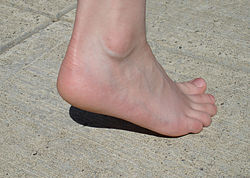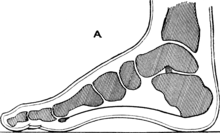Heel
| Heel | |
|---|---|
 A girl heel | |
| Details | |
| Identifiers | |
| Latin | calx |
| MeSH | D006365 |
| TA98 | A01.1.00.042 |
| TA2 | 167 |
| FMA | 24994 |
| Anatomical terminology | |
The heel is the prominence at the posterior end of the foot. It is based on the projection of one bone, the calcaneus or heel bone, behind the articulation of the bones of the lower leg.
Structure


To distribute the compressive forces exerted on the heel during
plantar aponeurosis above and the sole's skin
below. The sole of the foot is one of the most highly vascularized regions of the body surface, and the dense system of blood vessels further stabilize the septa.
[1]
The
plantar flexion, i.e. to stretch the foot downward. It is accompanied by a "fourth head", the slight plantaris muscle
, the long slender tendon of which is also attached to the heel bone but not visible.
[2]
Function
The compressive forces applied to the foot are distributed along five rays, three medial (side of big toe) and two lateral (side of little toe). The lateral rays stretch over the
balls of the large and little toes bear the brunt of the loads.[3]
Cracked heels
Cracked heels is a common health problem and it may cause
foot files
are available to cure and prevent it.
Other animals
In the long-footed mammals, both the hoofed species (
hock. In plantigrade species, it rests on the ground. In birds, the heel is the backward-pointing joint which is often mistaken as the "knee
" (the actual knee of birds is hidden under the plumage).
See also
Wikimedia Commons has media related to Heels.
Look up heel in Wiktionary, the free dictionary.
- Achilles' heel a metaphor for weakness
- Heel of Italy, the SE (after its position in the 'boot')
- Ball of the foot
- Calcaneal spur heel-bone
- Callus Hard skin which may cause painful cracks in the heel and sole of the foot
- Plantar fasciitis "policeman's heel" disorder
- High-heeled footwearfashion
- Squatting position
Notes
- ^ Thieme Atlas 2006, p 418
- ^ Thieme Atlas 2006, p 434
- ^ Thieme Atlas 2006, p 412
- ^ "Dry, Cracked Feet: Treatment, Causes, and Home Remedies". www.footvitals.com.
References
- Thieme Atlas of Anatomy: General Anatomy and Musculoskeletal System. Thieme. 2006. ISBN 1-58890-419-9.
